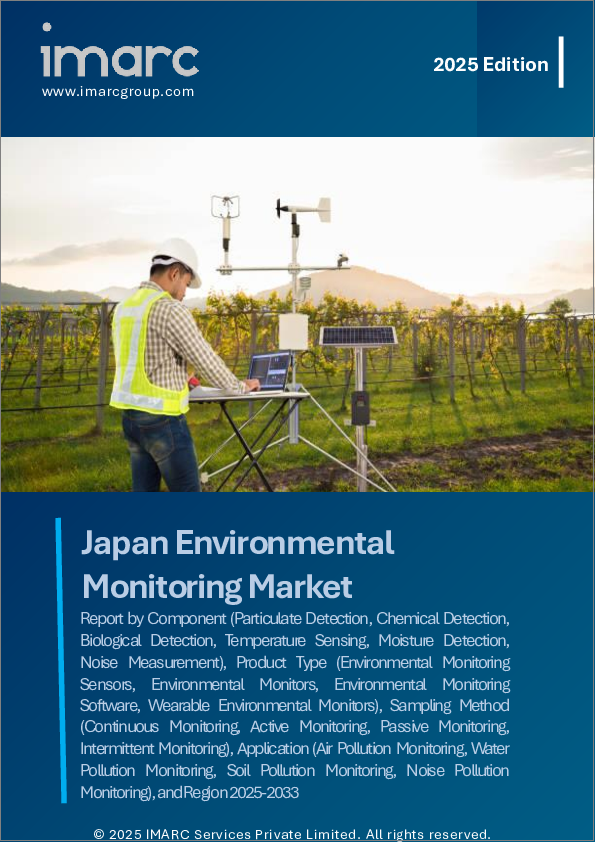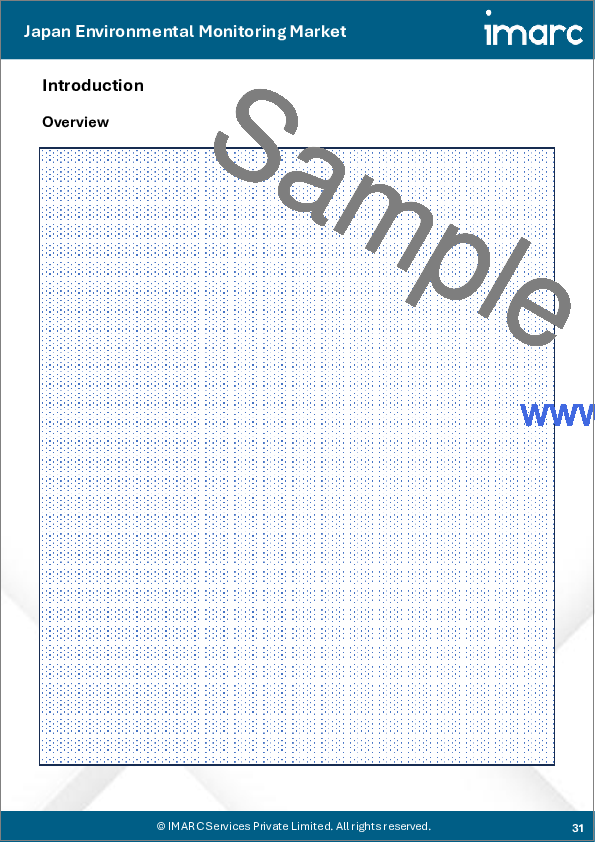|
|
市場調査レポート
商品コード
1609651
日本の環境モニタリング市場レポート:コンポーネント、製品タイプ、サンプリング方法、用途、地域別、2025年~2033年Japan Environmental Monitoring Market Report by Component, Product Type, Sampling Method, Application, and Region 2025-2033 |
||||||
カスタマイズ可能
|
|||||||
| 日本の環境モニタリング市場レポート:コンポーネント、製品タイプ、サンプリング方法、用途、地域別、2025年~2033年 |
|
出版日: 2024年12月05日
発行: IMARC
ページ情報: 英文 117 Pages
納期: 5~7営業日
|
全表示
- 概要
- 目次
日本の環境モニタリング市場の市場規模は2024年に9億2,040万米ドルに達しました。今後、IMARC Groupは、市場は2033年までに14億9,710万米ドルに達し、2025~2033年の成長率(CAGR)は5.7%になると予測しています。包括的で効果的なモニタリングソリューションのための様々な技術革新と、産業活動が環境に及ぼす全体的な影響を測定し、その悪影響を軽減することに対する組織内のニーズの高まりが、主に市場成長を促進しています。
本レポートで扱う主な質問
- 日本の環境モニタリング市場はこれまでどのように推移してきたか、また今後どのように推移するか?
- COVID-19が日本の環境モニタリング市場に与えた影響は?
- 日本の環境モニタリング市場の構成銘柄別の内訳は?
- 日本の環境モニタリング市場の製品タイプ別の内訳は?
- 日本の環境モニタリング市場のサンプリング方法別の内訳を教えてください。
- 日本の環境モニタリング市場の用途別の内訳は?
- 日本の環境モニタリング市場のバリューチェーンにはどのような段階がありますか?
- 日本の環境モニタリングにおける主な促進要因と課題は何か?
- 日本の環境モニタリング市場の構造と主要プレーヤーは?
- 日本の環境モニタリング市場における競合の程度は?
目次
第1章 序文
第2章 調査範囲と調査手法
- 調査の目的
- ステークホルダー
- データソース
- 市場推定
- 調査手法
第3章 エグゼクティブサマリー
第4章 日本の環境モニタリング市場-イントロダクション
- 概要
- 市場力学
- 業界動向
- 競合情報
第5章 日本の環境モニタリング市場情勢
- 過去および現在の市場動向(2019年~2024年)
- 市場予測(2025年~2033年)
第6章 日本の環境モニタリング市場- コンポーネント別の内訳
- 粒子検出
- 化学物質検出
- 生物学的検出
- 温度感知
- 水分検出
- 騒音測定
第7章 日本の環境モニタリング市場-製品タイプ別の内訳
- 環境モニタリングセンサー
- 環境モニター
- 環境モニタリングソフトウェア
- ウェアラブル環境モニター
第8章 日本の環境モニタリング市場- サンプリング方法別内訳
- 継続的な監視
- アクティブモニタリング
- パッシブモニタリング
- 断続的なモニタリング
第9章 日本の環境モニタリング市場- 用途別の内訳
- 大気汚染監視
- 水質汚染監視
- 土壌汚染モニタリング
- 騒音公害監視
第10章 日本の環境モニタリング市場-競合情勢
- 概要
- 市場構造
- 市場プレーヤーのポジショニング
- 主要成功戦略
- 競合ダッシュボード
- 企業評価象限
第11章 主要企業のプロファイル
第12章 日本の環境モニタリング市場- 業界分析
- 促進要因・抑制要因・機会
- ポーターのファイブフォース分析
- バリューチェーン分析
第13章 付録
Japan environmental monitoring market size reached USD 920.4 Million in 2024. Looking forward, IMARC Group expects the market to reach USD 1,497.1 Million by 2033, exhibiting a growth rate (CAGR) of 5.7% during 2025-2033. Various technological innovations for comprehensive and effective monitoring solutions, coupled with the elevating need among organizations for measuring the overall impact of industrial activities on the environment to mitigate their adverse effects, are primarily driving the market growth.
Environmental monitoring encompasses the use of diverse tools and methods to evaluate the influence of an activity on the environment. This entails a central hub for data management, validation for compliance checks, automated alerts for environmental monitoring, and quality control measures. Its applications extend to safeguarding public water supplies, overseeing the management of hazardous and radioactive waste, and pinpointing and analyzing sources of pollution. Additionally, environmental monitoring plays a crucial role in allocating resources for land planning and economic development, preserving endangered species, mitigating risks, and ensuring the protection of human health. Due to these multifaceted applications, environmental monitoring is gaining increased attention and recognition.
Japan Environmental Monitoring Market Trends:
The Japan environmental monitoring market is experiencing a positive upswing due to the escalating pollution levels, attributed to rapid urbanization and industrialization. Besides this, environmental monitoring plays a pivotal role in identifying and tracking changes in various parameters, including temperature, humidity, noise levels, biological and chemical air pollutants, and water quality, which is positively influencing the regional market. Moreover, governments of Japan are increasingly enforcing stringent regulations for monitoring and mitigating pollution, aligning with the growing concerns about health, rising mortality rates, and the imperative for improved resource management, thereby bolstering the market growth. Additionally, the reduced costs of wireless connectivity components and sensors contribute as a significant growth factor. The market is further propelled by advancements in wireless cellular and non-cellular communication technologies, allowing the deployment of environmental monitoring systems in remote and confined locations. These technologies facilitate effective tracking of water contamination and pollution levels, aiding in the establishment of environmental baseline standards. Additionally, the incorporation of big data analytics, advancements in sensor technology, and the development of Internet of Things (IoT)-specific cellular network connectivity solutions are anticipated to provide momentum to market growth over the forecasted period.
Japan Environmental Monitoring Market Segmentation:
Component Insights:
- Particulate Detection
- Chemical Detection
- Biological Detection
- Temperature Sensing
- Moisture Detection
- Noise Measurement
Product Type Insights:
- Environmental Monitoring Sensors
- Environmental Monitors
- Environmental Monitoring Software
- Wearable Environmental Monitors
Sampling Method Insights:
- Continuous Monitoring
- Active Monitoring
- Passive Monitoring
- Intermittent Monitoring
Application Insights:
- Air Pollution Monitoring
- Water Pollution Monitoring
- Soil Pollution Monitoring
- Noise Pollution Monitoring
Competitive Landscape:
The market research report has also provided a comprehensive analysis of the competitive landscape. Competitive analysis such as market structure, key player positioning, top winning strategies, competitive dashboard, and company evaluation quadrant has been covered in the report. Also, detailed profiles of all major companies have been provided.
Key Questions Answered in This Report:
- How has the Japan environmental monitoring market performed so far and how will it perform in the coming years?
- What has been the impact of COVID-19 on the Japan environmental monitoring market?
- What is the breakup of the Japan environmental monitoring market on the basis of component?
- What is the breakup of the Japan environmental monitoring market on the basis of product type?
- What is the breakup of the Japan environmental monitoring market on the basis of sampling method?
- What is the breakup of the Japan environmental monitoring market on the basis of application?
- What are the various stages in the value chain of the Japan environmental monitoring market?
- What are the key driving factors and challenges in the Japan environmental monitoring?
- What is the structure of the Japan environmental monitoring market and who are the key players?
- What is the degree of competition in the Japan environmental monitoring market?
Table of Contents
1 Preface
2 Scope and Methodology
- 2.1 Objectives of the Study
- 2.2 Stakeholders
- 2.3 Data Sources
- 2.3.1 Primary Sources
- 2.3.2 Secondary Sources
- 2.4 Market Estimation
- 2.4.1 Bottom-Up Approach
- 2.4.2 Top-Down Approach
- 2.5 Forecasting Methodology
3 Executive Summary
4 Japan Environmental Monitoring Market - Introduction
- 4.1 Overview
- 4.2 Market Dynamics
- 4.3 Industry Trends
- 4.4 Competitive Intelligence
5 Japan Environmental Monitoring Market Landscape
- 5.1 Historical and Current Market Trends (2019-2024)
- 5.2 Market Forecast (2025-2033)
6 Japan Environmental Monitoring Market - Breakup by Component
- 6.1 Particulate Detection
- 6.1.1 Overview
- 6.1.2 Historical and Current Market Trends (2019-2024)
- 6.1.3 Market Forecast (2025-2033)
- 6.2 Chemical Detection
- 6.2.1 Overview
- 6.2.2 Historical and Current Market Trends (2019-2024)
- 6.2.3 Market Forecast (2025-2033)
- 6.3 Biological Detection
- 6.3.1 Overview
- 6.3.2 Historical and Current Market Trends (2019-2024)
- 6.3.3 Market Forecast (2025-2033)
- 6.4 Temperature Sensing
- 6.4.1 Overview
- 6.4.2 Historical and Current Market Trends (2019-2024)
- 6.4.3 Market Forecast (2025-2033)
- 6.5 Moisture Detection
- 6.5.1 Overview
- 6.5.2 Historical and Current Market Trends (2019-2024)
- 6.5.3 Market Forecast (2025-2033)
- 6.6 Noise Measurement
- 6.6.1 Overview
- 6.6.2 Historical and Current Market Trends (2019-2024)
- 6.6.3 Market Forecast (2025-2033)
7 Japan Environmental Monitoring Market - Breakup by Product Type
- 7.1 Environmental Monitoring Sensors
- 7.1.1 Overview
- 7.1.2 Historical and Current Market Trends (2019-2024)
- 7.1.3 Market Forecast (2025-2033)
- 7.2 Environmental Monitors
- 7.2.1 Overview
- 7.2.2 Historical and Current Market Trends (2019-2024)
- 7.2.3 Market Forecast (2025-2033)
- 7.3 Environmental Monitoring Software
- 7.3.1 Overview
- 7.3.2 Historical and Current Market Trends (2019-2024)
- 7.3.3 Market Forecast (2025-2033)
- 7.4 Wearable Environmental Monitors
- 7.4.1 Overview
- 7.4.2 Historical and Current Market Trends (2019-2024)
- 7.4.3 Market Forecast (2025-2033)
8 Japan Environmental Monitoring Market - Breakup by Sampling Method
- 8.1 Continuous Monitoring
- 8.1.1 Overview
- 8.1.2 Historical and Current Market Trends (2019-2024)
- 8.1.3 Market Forecast (2025-2033)
- 8.2 Active Monitoring
- 8.2.1 Overview
- 8.2.2 Historical and Current Market Trends (2019-2024)
- 8.2.3 Market Forecast (2025-2033)
- 8.3 Passive Monitoring
- 8.3.1 Overview
- 8.3.2 Historical and Current Market Trends (2019-2024)
- 8.3.3 Market Forecast (2025-2033)
- 8.4 Intermittent Monitoring
- 8.4.1 Overview
- 8.4.2 Historical and Current Market Trends (2019-2024)
- 8.4.3 Market Forecast (2025-2033)
9 Japan Environmental Monitoring Market - Breakup by Application
- 9.1 Air Pollution Monitoring
- 9.1.1 Overview
- 9.1.2 Historical and Current Market Trends (2019-2024)
- 9.1.3 Market Forecast (2025-2033)
- 9.2 Water Pollution Monitoring
- 9.2.1 Overview
- 9.2.2 Historical and Current Market Trends (2019-2024)
- 9.2.3 Market Forecast (2025-2033)
- 9.3 Soil Pollution Monitoring
- 9.3.1 Overview
- 9.3.2 Historical and Current Market Trends (2019-2024)
- 9.3.3 Market Forecast (2025-2033)
- 9.4 Noise Pollution Monitoring
- 9.4.1 Overview
- 9.4.2 Historical and Current Market Trends (2019-2024)
- 9.4.3 Market Forecast (2025-2033)
10 Japan Environmental Monitoring Market - Competitive Landscape
- 10.1 Overview
- 10.2 Market Structure
- 10.3 Market Player Positioning
- 10.4 Top Winning Strategies
- 10.5 Competitive Dashboard
- 10.6 Company Evaluation Quadrant
11 Profiles of Key Players
- 11.1 Company A
- 11.1.1 Business Overview
- 11.1.2 Product Portfolio
- 11.1.3 Business Strategies
- 11.1.4 SWOT Analysis
- 11.1.5 Major News and Events
- 11.2 Company B
- 11.2.1 Business Overview
- 11.2.2 Product Portfolio
- 11.2.3 Business Strategies
- 11.2.4 SWOT Analysis
- 11.2.5 Major News and Events
- 11.3 Company C
- 11.3.1 Business Overview
- 11.3.2 Product Portfolio
- 11.3.3 Business Strategies
- 11.3.4 SWOT Analysis
- 11.3.5 Major News and Events
- 11.4 Company D
- 11.4.1 Business Overview
- 11.4.2 Product Portfolio
- 11.4.3 Business Strategies
- 11.4.4 SWOT Analysis
- 11.4.5 Major News and Events
- 11.5 Company E
- 11.5.1 Business Overview
- 11.5.2 Product Portfolio
- 11.5.3 Business Strategies
- 11.5.4 SWOT Analysis
- 11.5.5 Major News and Events
12 Japan Environmental Monitoring Market - Industry Analysis
- 12.1 Drivers, Restraints, and Opportunities
- 12.1.1 Overview
- 12.1.2 Drivers
- 12.1.3 Restraints
- 12.1.4 Opportunities
- 12.2 Porters Five Forces Analysis
- 12.2.1 Overview
- 12.2.2 Bargaining Power of Buyers
- 12.2.3 Bargaining Power of Suppliers
- 12.2.4 Degree of Competition
- 12.2.5 Threat of New Entrants
- 12.2.6 Threat of Substitutes
- 12.3 Value Chain Analysis





